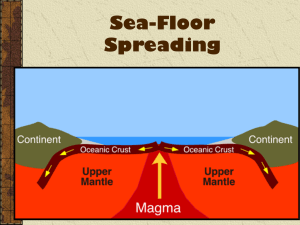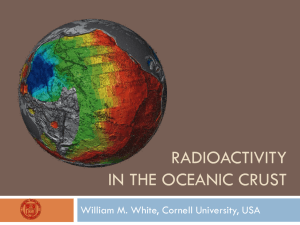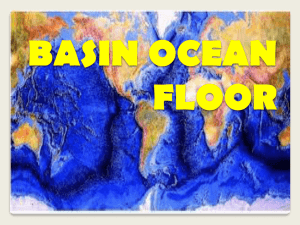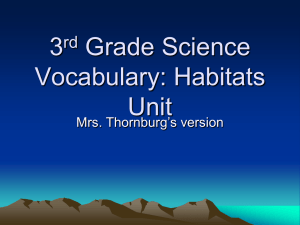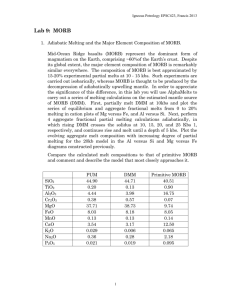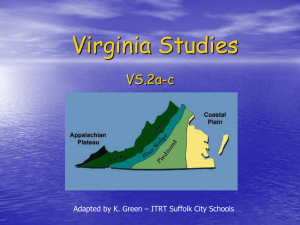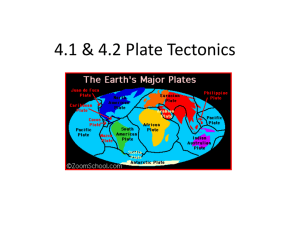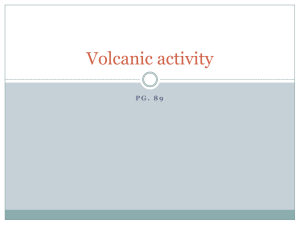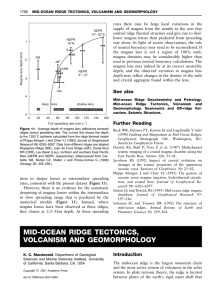Petrology Lecture 7
advertisement
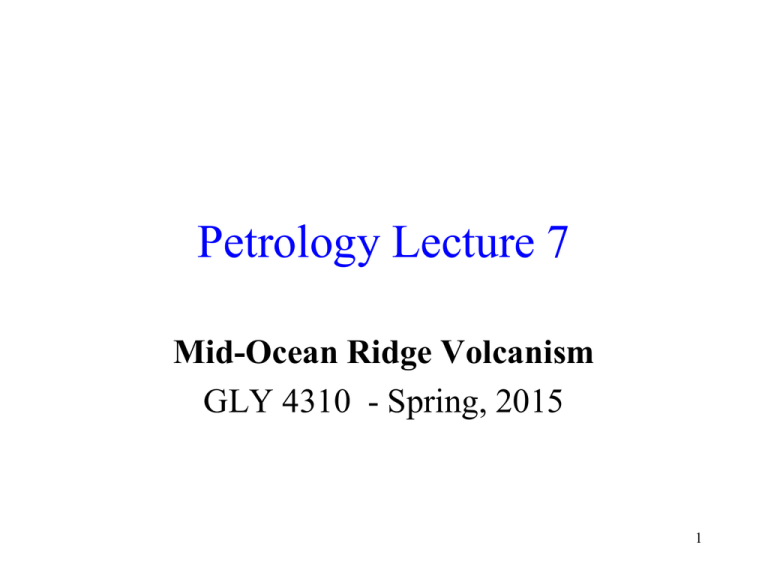
Petrology Lecture 7 Mid-Ocean Ridge Volcanism GLY 4310 - Spring, 2015 1 MOR System 2 Table 13-1. Spreading Rates of Some Mid-Ocean Ridge Segments Category Ridge Fast East Pacific Rise Slow Indian Ocean Mid-Atlantic Ridge Latitude 21-23oN 13oN 11oN 8-9oN 2 oN 20-21oS 33oS 54oS 56oS SW SE Central 85oN 45oN 36oN 23oN 48oS Rate (cm/a)* 3 5.3 5.6 6 6.3 8 5.5 4 4.6 1 3-3.7 0.9 0.6 1-3 2.2 1.3 1.8 MOR Spreading Rates From Wilson (1989). Data from Hekinian (1982), Sclater et al . (1976), Jackson and Reid (1983). *half spreading 3 Oceanic Crust Cross-Section Figure 13-5 Modified after Brown and Mussett (1993) The Inaccessible Earth: An Integrated View of Its Structure and Composition. Chapman & Hall. London. 4 Oceanic Crust & Upper Mantle Structure Layer 1 A thin layer of pelagic sediment Oceanic Crust & Upper Mantle Structure Layer 2 is basaltic Subdivided into two sub-layers Layer 2A & B = pillow basalts Layer 2C = vertical sheeted dikes Layer 3 more complex and controversial Believed to be mostly gabbros, crystallized from a shallow axial magma chamber (feeds the dikes and basalts) Layer 3A = upper isotropic and lower, somewhat foliated (“transitional”) gabbros Layer 3B is more layered, & may exhibit cumulate textures Oceanic Crust & Upper Mantle Structure Discontinuous diorite and tonalite (“plagiogranite”) bodies = late differentiated liquids Figure 13.4. Lithology and thickness of a typical ophiolite sequence, based on the Samial Ophiolite in Oman. After Boudier and Nicolas (1985) Earth Planet. Sci. Lett., 76, 84-92. Layer 4 = ultramafic rocks Ophiolites: base of 3B grades into layered cumulate wehrlite & gabbro Wehrlite intruded into layered gabbros Below cumulate dunite with harzburgite xenoliths Below this is a tectonite harzburgite and dunite (unmelted residuum of the original mantle) Table 13-2. Average Analyses and CIPW Norms of MORBs (BVTP Table 1.2.5.2) Oxide (wt%) SiO2 TiO2 Al2O3 FeO* MgO CaO Na2O K2O P2O5 Total All 50.5 1.56 15.3 10.5 7.47 11.5 2.62 0.16 0.13 99.74 MAR 50.7 1.49 15.6 9.85 7.69 11.4 2.66 0.17 0.12 99.68 EPR 50.2 1.77 14.9 11.3 7.10 11.4 2.66 0.16 0.14 99.63 IOR 50.9 1.19 15.2 10.3 7.69 11.8 2.32 0.14 0.10 99.64 Norm q or ab an di hy ol mt il ap 0.94 0.95 22.17 29.44 21.62 17.19 0.0 4.44 2.96 0.30 0.76 1.0 22.51 30.13 20.84 17.32 0.0 4.34 2.83 0.28 0.93 0.95 22.51 28.14 22.5 16.53 0.0 4.74 3.36 0.32 1.60 0.83 19.64 30.53 22.38 18.62 0.0 3.90 2.26 0.23 Chemical Analyses of MORB All: Ave of glasses from Atlantic, Pacific and Indian Ocean ridges. MAR: Ave. of MAR glasses. EPR: Ave. of EPR glasses. IOR: Ave. of Indian Ocean ridge glasses. 10 Fenner Diagrams for MORB Figure 13-6. “Fenner-type” variation diagrams for basaltic glasses from the Amar region of the MAR. Note different ordinate scales. From Stakes et al. (1984) J. Geophys. Res., 89, 6995-7028. 11 CaO/Al2O3 vs. Mg. Figure 13-7. From Stakes et al. (1984) J. Geophys. Res., 89, 6995-7028. 12 MORB Variation Diagrams Figure 13-8. Data from Schilling et al. (1983) Amer. J. Sci., 283, 510-586. 13 Glass Composition: Slow vs. Fast Spreading Ridges Figure 13-9. Histograms of over 1600 glass compositions from slow and fast mid-ocean ridges. After Sinton and Detrick (1992) J. Geophys. Res., 97, 197-216. 14 K2O vs. Mg for MAR MORB 15 REE Patterns for MAR MORBS Figure 13-11. Data from Schilling et al. (1983) Amer. J. Sci., 283, 510-586. 16 LREE vs. Mg# • Blue = E-Morb • Red = N-Morb • Green = T-Morb Figure 13-12. Data from Schilling et al. (1983) Amer. J. Sci., 283, 510-586. 17 143Nd/ 144Nd vs. 87Sr/ 86Sr Figure 13-13. Data from Ito et al. (1987) Chemical Geology, 62, 157-176; and LeRoex et al. (1983) J. Petrol., 24, 267-318. 18 Generation of N-MORB and EMORB Figure 13-14. After Zindler et al. (1984) Earth Planet. Sci. Lett., 70, 175 -195. and Wilson (1989) Igneous Petrogenesis, 19 Kluwer. The Axial Magma Chamber Original Model • Semi-permanent • Fractional crystallization derivative MORB magmas • Periodic reinjection of fresh, primitive MORB • Dikes upward through extending/faulting roof Figure 13.16. From Byran and Moore (1977) Geol. Soc. Amer. Bull., 88, 556-570. Hekinian et al. (1976) Contr. Min. Pet. 58, 107. Semi-Permanent Axial Magma Chamber • Infinite onion model, since it resembled an infinite number of onion shells created from within and added to the walls 21 Axial Magma Chamber, Fast-Spreading Ridge Figure 1317. After Perfit et al. (1994) Geology, 22, 375-379. 22 Crystal Mush Zone The crystal mush zone contains perhaps 30% melt and constitutes an excellent boundary layer for the in situ crystallization process proposed by Langmuir Figure 11.12 From Winter (2001) An Introduction to Igneous and Metamorphic Petrology. Prentice Hall Discontinuous Axial Magma Chamber Figure 13-21 After Sinton and Detrick (1992) J. Geophys. Res., 97, 197-216. 24 Axial Magma Chamber, Slow-Spreading Ridge Depth (km) 2 Rift Valley 4 Gabbro 6 Moho Transition zone Mush 8 10 5 0 Distance (km) 5 10 Figure 13.22 After Sinton and Detrick (1992) J. Geophys. Res., 97, 197-216 25 Oceanic Basalt • Figure 10-16 (a) Initial 143Nd/144Nd vs. 87Sr/86Sr for oceanic basalts. From Wilson (1989). Igneous Petrogenesis. Unwin Hyman/Kluwer. Data from Zindler et al. (1982) and Menzies 26 (1983). Ultramafic Xenoliths • Figure 10-16 (b) Initial 143Nd/144Nd vs. 87Sr/86Sr for mantle xenoliths. From Wilson (1989). Igneous Petrogenesis. Unwin Hyman/Kluwer. Data from Zindler et 27 al. (1982) and Menzies (1983).
